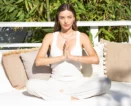Prana is energy and it rides along our breath, traveling through the subtle body in channels called nadis. Yama means control or restraint. Pranayama is breath control. Pranayama is practiced for the sake of gaining mastery over the body and mind and raising energy towards higher levels of consciousness. It is the 4th limb of Ashtanga yoga, as outlined in Master Patanjali’s Yoga Sutra.
When we practice pranayama, we focus and regulate the breath, making conscious an unconscious action we do mindlessly all day. When we bring the breath under our control, the mind follows. The fluctuations of the mind, vrittis in Sanskrit, are relaxed as the entire body system is brought under control. The benefits of practicing prananyama are multi-fold, ranging from the purification of the gross, physical body to the activation of the subtle, spiritual Self. Patanjali writes, “As a result (of practicing pranayama), the veil over the inner Light is destroyed” (Yoga Sutra II:52), meaning that pranayama helps to destroy the illusion of who we think we are and gives way to the shining light within each of us. Through the practice of prananyama, we reveal to ourselves our true nature and our true Self.
In the practice of yoga there are many pranayama practices, like Nadi Shodhanai (Alternate Nostril breathing), Kappalalbhati (Skull Shining breath) and Ujjayi (Victorious breath). Ujjayi breath should be practiced while doing asana, whereas Nadi Shodhana and Kappalbhati should be practiced while sitting in a meditative seat before or after the asana practice.
If you want to begin to tap into breath control, harnessing your mind and strengthening your body through pranayama, begin to pay attention to your breath. Try to even out your inhales and exhales and slow down your breathing without straining. Notice how when your stressed or nervous, your breath becomes very shallow and taking a deep breath can instantly set the mind a ease.
An easy practice of sama vritti pranayama, meaning “same turns”, can instantly put the mind and body at ease and is safe for everyone to practice. Find a comfortable seat and lengthen your spine. Close the eyes. Exhale all the air out of the lungs by drawing the navel towards the spine. Inhale through the nose on a count of four, filling the chest and abdomen. Exhale on the same 4 count, moving the breath up and out through the nose. Practice several rounds of inhales and exhales, then release the control of your breath and sit in stillness for a few moments, observing the effects of regulating your inhales and exhales.













